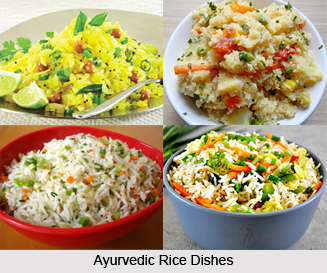 Ayurvedic rice dishes are included in the Ayurvedic diet as they help to achieve that desired health balance. Moreover, rice is the widely consumed food in many parts of India so emphasizing on rice dishes is of utmost importance. But according to the recommendation of Ayurveda, Ayurvedic rice dishes should be consumed with utter care. Ayurvedic rice dishes are good for Vata and Pitta but for Kapha it should be eaten moderately. Ayurveda says that brown rice should be replaced with white rice as it is difficult to digest, too heating for Pitta and too heavy for Kapha.
Ayurvedic rice dishes are included in the Ayurvedic diet as they help to achieve that desired health balance. Moreover, rice is the widely consumed food in many parts of India so emphasizing on rice dishes is of utmost importance. But according to the recommendation of Ayurveda, Ayurvedic rice dishes should be consumed with utter care. Ayurvedic rice dishes are good for Vata and Pitta but for Kapha it should be eaten moderately. Ayurveda says that brown rice should be replaced with white rice as it is difficult to digest, too heating for Pitta and too heavy for Kapha.
Following are some of the dishes along with their benefits that come under the umbrella of Ayurvedic rice dishes:
Plain/ Basmati Rice: Plain rice balances Vata and Pitta doshas. Kapha types, however, should avoid eating rice too often. Dry-roasting it before eating will reduce the heaviness. It can be cooked by combining with beans, nuts, vegetables, fruits, and milk to make it nutritious. Ayurveda also recommends consumption of long-grained, fragrant basmati rice as it is easy on the digestive system. Basmati rice is also saatvic or pure, and balances the physiology. It builds body tissue and is very high on prana or vital life energy.
Fried Rice: Fried rice is made up of spices and hence it is more light and a good appetizer. Saffron rice is easy to digest and good for allergic conditions especially food allergy. It is effective in purifying the blood, circulation and the female reproductive system. Fried rice contains potassium which is a natural analgesic and plays a pivotal role in maintenance of blood pressure along with sodium. Fried rice also helps in maintaining fluid balance in the body. But one has to keep in mind that fried rice is good only if it is consumed on moderation.
Poha: Poha is basically uncooked rice flake. It is light on the stomach and easy to digest. This rice based nutritious snack is a source of instant energy. Rice provides vitamin B1 and stabilizes the blood sugar. And the peanuts contained in Poha are good source of protein which is considered good for the heart.
Upma: Upma is the light diet usually taken as a breakfast item. This dish is also loaded with nutrition and is known to soothe stomach. Upma is enriched with iron, protein and vitamins and contains low-fat, low-calorie, and high dietary fibre.





